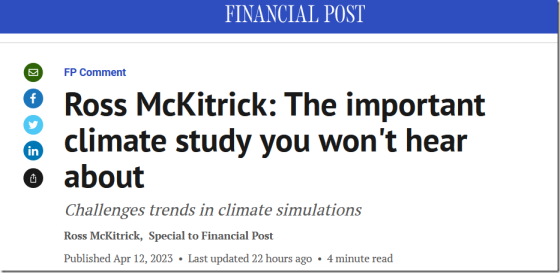by J. Mason, May 23, 2023 in SkepicalScience
At a glance
Earth’s surface, oceans and atmosphere are all warming due to our greenhouse gasemissions, but at different rates. Some places are also warming much faster than others: parts of the Arctic for example. That variability is partly because other phenomena act to offset or enhance warming at times. A good example are the effects of La Nina and El Nino, an irregular variation in winds and sea surface temperatures over the tropical eastern Pacific Ocean that can influence temperatures and rainfall patterns right around the world.
El Nino causes even warmer years whereas La Nina tends to peg temperatures back to an extent. Thus 2016 – an El Nino year – was the warmest year on record, according to the USA-based National Oceanic and Atmospheric Administration, but other recent years have not been far behind – 2020 and 2019 are in second and third place respectively. The worrying thing is that 2019 only saw a mild El Nino and 2020 was “neutral” – there were neither El Nino or La Nina conditions. And even with a La Nina featuring, 2021 and 2022were, respectively, still the seventh and sixth hottest years on record.
The year 1998 featured a massive El Nino and consequent temperature spike that was a strong outlier, well above the steady upward trend. That spike and the subsequent return to a more “normal” warming pattern led to claims in the popular media that global warming had “paused” or had even stopped. This was a typical misinformation tactic that, as usual, time has proved wrong. As things currently stand, the top ten warmest years have all been since 2010 and 1998 is nowhere to be seen any more. By modern standards, it simply wasn’t warm enough.
Please use this form to provide feedback about this new “at a glance” section. Read a more technical version via the link below!
Click for Further details
In case you’d like to explore more of our recently updated rebuttals, here are the links to all of them:
Myths with link to rebuttal Short URLs Ice age predicted in the 1970s sks.to/1970s It hasn’t warmed since 1998 sks.to/1998 Antarctica is gaining ice sks.to/antarctica CRU emails suggest conspiracy sks.to/climategate What evidence is there for the hockey stick sks.to/hockey CO2 lags temperature sks.to/lag Climate‘s changed before sks.to/past It’s the sun sks.to/sun Temperature records are unreliable sks.to/temp The greenhouse effect and the 2nd law of thermodynamics sks.to/thermo We’re heading into an ice age sks.to/iceage Positives and negatives of global warming sks.to/impacts Global cooling – Is global warming still happening? sks.to/cooling









































































